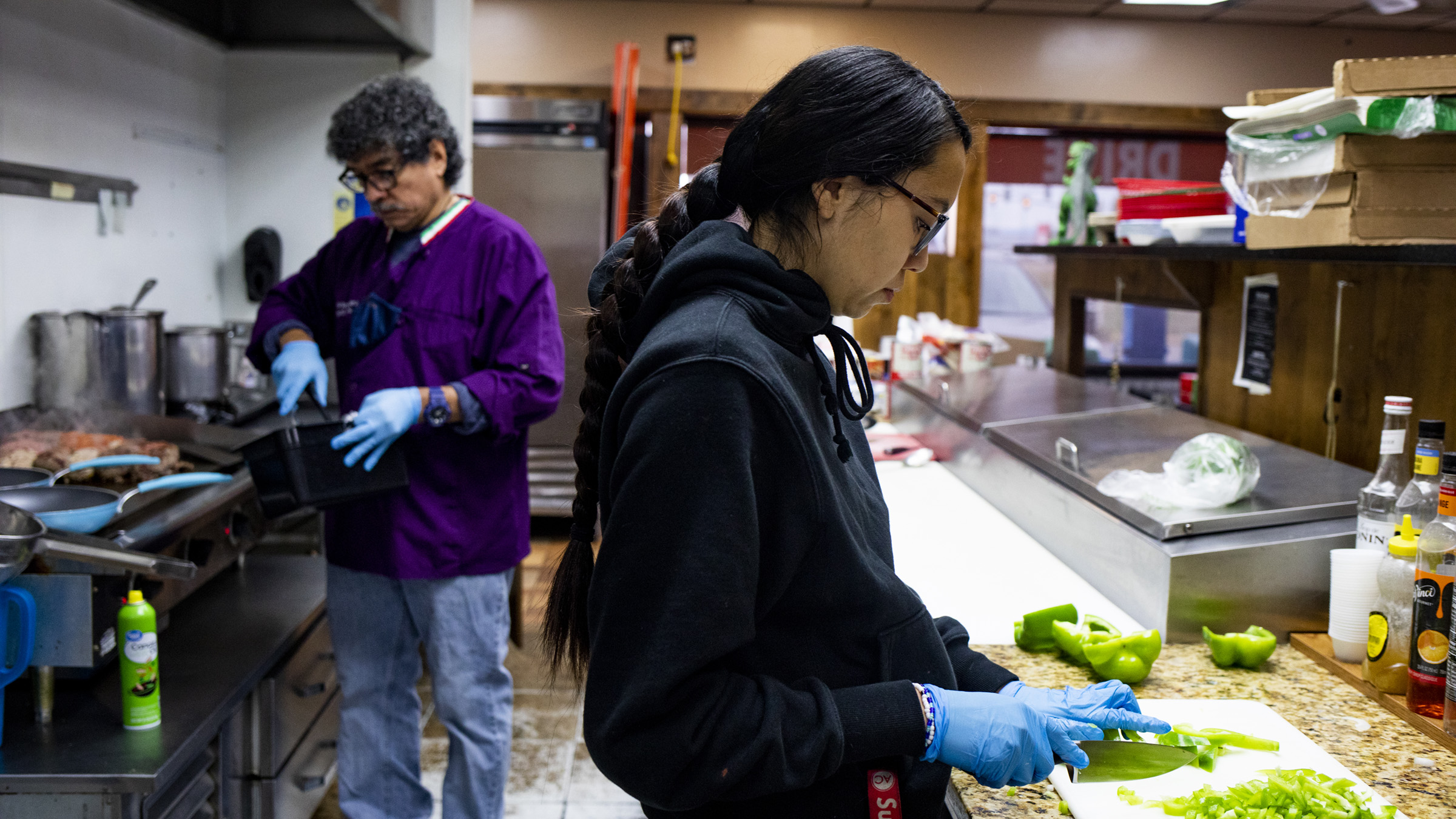In 2020, Center for Indian Country Development (CICD) partnered with the National Center for American Indian Enterprise Development (NCAIED) to survey Native-owned businesses in Indian Country about their experiences of and perspectives on doing business on and off reservations. Respondents reported a mixture of challenges and advantages. For example, respondents perceive that it takes longer to open a business on reservation than off and that businesses operating on reservations have lower sales and more limited access to markets, financial or otherwise. On the other hand, respondents indicated that opening a business on a reservation offers tax advantages and enables proximity to family and friends. The survey findings, discussed in more detail below, are part of an effort to learn more about the key obstacles to economic development in Indian Country.
Starting businesses on reservations may take somewhat longer
To help CICD and NCAIED researchers better understand the reality and perception of how easy it is to start a business in tribal areas, the survey asked whether “Opening a business on a reservation is quicker than opening a business off a reservation.” Respondents who operate businesses off reservations were more negative about the speed of opening a business on a reservation than those who operate businesses on reservations. Of respondents who operate businesses on reservations and had enough information to respond, 36 percent agreed or strongly agreed that it was quicker to open on-reservation, but 39 percent disagreed or strongly disagreed. (See Figure 1.) Among respondents doing business off-reservation who felt they had enough information to respond, only 21 percent agreed or strongly agreed that it was quicker to open on the reservation, while 49 percent disagreed or strongly disagreed. (Not shown in figure.) However, many respondents were uncertain: more than one-third of off-reservation business owners did not feel they had enough information to agree or disagree.
These imbalances may suggest some sorting between those who choose to operate on- and off-reservation. Business leaders who perceive more barriers to operating on a reservation are presumably more likely to choose to operate their business off-reservation.
Moving beyond perceptions of time to open a business, the survey also asked respondents how long it took them to complete three stages in the business-approval process. Responses showed that:
- Determining the necessary approvals took slightly less time for respondents operating off-reservation businesses than for those operating on-reservation businesses: 28 percent of off-reservation businesses had determined what approvals they needed in one week or less, compared to 20 percent of on-reservation businesses. Among off-reservation businesses, 42 percent had determined what approvals they needed in one month or less, compared to 49 percent of on-reservation businesses. Relatively equal shares—28 percent of on-reservation businesses and 32 percent of off-reservation businesses—needed six months or more to determine the needed approvals.
- Applying for approvals took slightly less time for respondents operating off-reservation businesses than for those operating on-reservation businesses: 34 percent of off-reservation businesses had applied for approvals in one week or less, compared to 20 percent of on-reservation businesses. However, applying for approvals took six months or more for one-quarter of both off-reservation businesses and on-reservation businesses.
- Waiting for approvals went quicker for some off-reservation businesses: 28 percent of businesses off-reservation received their necessary approvals within one week, compared to 19 percent of on-reservation businesses. However, 54 percent of off-reservation businesses waited up to a month for their approvals. Among on-reservation businesses, 44 percent waited up to a month. (See Figure 2.)
Overall, respondents believed that opening a business off-reservation was somewhat quicker than opening one on a reservation. However, given the relatively small sample, these differences are subject to significant statistical uncertainty.
Businesses on reservations have similar operating costs, fewer sales
The survey found that the perceived cost of doing business is similar on and off reservations. On average, businesses do not perceive systematically higher costs of operation on-reservation. (See Figure 3.) Perhaps in a case of “the grass is always greener on the other side of the fence,” those who operate businesses off a reservation are more likely than those on a reservation to believe that on-reservation businesses face lower costs.
However, sales were a different matter: respondents on- and off-reservation tended to disagree that “Operating a business on the reservation results in greater sales than off the reservation.” (See Figure 4.) Only 11 percent of respondents who operated off-reservation and 16 percent of respondents who operated on-reservation believed that operating on a reservation would result in greater sales. This is consistent with the explanation that, for historical reasons, reservations lack sufficiently dense concentrations of economic activity, or “economic clusters,” potentially making it preferable for entrepreneurs to locate somewhere with pre-existing clusters (Pascal and Stewart 2008) or ready access to the benefits of these clusters through robust infrastructure. But other explanations are also possible: for example, perceived sales disparities could be due to differences in the age and income distribution of potential consumers on- and off-reservation.
Advantages to operating a business on-reservation
Respondents identified distinct advantages of operating a business on- or off-reservation. Nearly 50 percent of respondents suggested that knowing the area was an advantage of being on-reservation or that there are tax advantages to having a business on-reservation. Over 40 percent of respondents said that being closer to family and friends was an advantage on-reservation. Far fewer respondents specified these as advantages off-reservation. By contrast, 44 percent and 45 percent of respondents, respectively, indicated that business support and having faster and more reliable Internet access were advantages of locating off-reservation. Small shares—only 8 percent and 1 percent of respondents, respectively—identified these as being advantages on-reservation. Having more financing options and an easier time finding a storefront were other significant advantages respondents identified with having their business off-reservation. (See Figure 5.)
Interestingly, a large share of off-reservation businesses indicated that they did not have enough information or familiarity with the reservation to answer the question. This suggests that lack of information about doing business on-reservation may be an additional barrier to private-sector growth in Indian Country.
No single strategy is sufficient
The results of this survey reinforce that no single strategy to eliminate barriers to private-sector economic activity in Indian Country will be sufficient. Though there are fewer business establishments on reservations relative to surrounding geographies (Akee et al. 2019), there is no consensus on significant factors creating this gap. Consistent with these survey results, contributing factors include the general difficulty in accessing markets due to a lack of physical and technological infrastructure, such as reliable broadband or well-maintained roads (National Congress of American Indians 2017); the lack of technical supports to Native entrepreneurs (Malkin et al. 2004, Stewart and Schwartz 2007); unclear or burdensome tribal laws (Cornell et al., 2006);* and greater set-up costs due to federal oversight and regulations of land and assets (Shoemaker 2019, Hallabrandt et al. 2004, Miller 2001, Haddock and Miller 2004). Even the streamlining of regulatory hurdles is unlikely to be sufficient to create rapid growth in the short run unless there are ways to increase access to markets and overcome the perceived disparities in sales potential. Additionally, Native business owners would benefit from expanded business supports and improved technological infrastructure.
Taken together, the evidence from this survey suggests that Native business owners face significant sales challenges operating their businesses on-reservation. Additionally, business owners perceive disadvantages to operating on-reservation, such as weak business support, more limited access to financing, and a lack of reliable Internet access. However, despite these perceptions, many Native business owners locate their businesses on reservations because they know the area and have the opportunity to be closer to family and friends.
The author thanks Chris James, president and CEO of NCAIED and CICD Leadership Council member, for promoting the survey in Indian Country. Additionally, the author thanks Christian Dippel and Bryan Leonard for all their valuable discussions early in this project, as well as Dominic Parker and Terry Anderson.
About the survey
The online survey, which also included questions about the impacts of the COVID-19 pandemic on operations, was distributed to NCAIED’s email distribution list and promoted on social media. The survey was open July 13–21, 2020. The body of the email and the landing page of the survey informed participants that the survey focused on “the tribal business environment and the impact/needs stemming from the COVID-19 pandemic” and that upon completing the survey and providing their email address, they would be entered in a raffle sponsored by NCAIED and CICD. (Email addresses were collected with the sole purpose of ensuring winners of the raffle could be re-contacted.) Participants were informed that all their responses would remain anonymous and that only aggregated data would be shared publicly. They were also informed that taking part in the survey was completely voluntary and that they could skip any questions they would prefer not to answer, but that if they withdrew early from the survey, they would not be entered in the raffle. The survey took approximately ten minutes to complete.
The key questions of interest for this study in the order in which they were asked in the survey are:
- How strongly do you agree with the following statement? (Opening a business on a reservation is quicker than opening a business off a reservation; Operating a business on a reservation is lower-cost than operating a business off a reservation; Operating a business on the reservation results in greater sales than off the reservation)
- What do you see as the advantage of having your business on the reservation? (select all that apply)
- What do you see as the advantage of having your business off the reservation? (select all that apply)
- Approximately how much time did you spend doing the following when you decided to open your business until the date you opened? (Determining the necessary approvals; Applying for necessary approvals; Waiting for necessary approvals)
The survey also collected contextual information about the businesses and their owners, in order for CICD and NCAIED researchers to understand how representative the survey may be of Native business owners nationally and to account for any differences in characteristics of on- and off-reservation businesses when analyzing the cost of doing business on reservation lands.
Respondents were asked to “select all that apply” about their businesses’ 1) main office, and 2) location of most employees, and were then presented with a list of options that included on-reservation, off-reservation, urban, and rural. Many participants only selected one option. For example, some selected “rural” but then did not report whether their business was on- or off-reservation. Businesses are defined as on-reservation if the respondent explicitly selected that most of their employees are on-reservation. Otherwise, businesses are defined as off-reservation. (Defining on-reservation as having their main office on-reservation yields similar results. Only seven respondents reported that their main office and most of their employees are in different locations.)
While the survey received more than 400 valid responses, only a subset of these were from businesses that were owned by Native individuals and not owned by a tribal nation. The results presented here are for the 258 respondents who responded to all the key outcome variables of interest, were at least 51 percent Native-owned, and not owned by a tribe. (Most of the loss in sample size comes from non-response.) Those that responded that the time it took to open their business was “not applicable” were also excluded (44 respondents).
The survey included several variables that can help CICD and NCAIED researchers understand the characteristics of businesses in the sample:
- Female-owned enterprises make up approximately 40 percent of both businesses located on- and off-reservation.
- About half of the business are not incorporated.
- Most businesses are majority-owned by an enrolled citizen of a tribal nation, with more businesses on-reservation being owned by tribal citizens (90 percent vs. 80 percent, respectively). The survey allowed someone to identify as Native without being an enrolled citizen of a tribe.
- Generally, the respondents are highly educated: 39 percent of on-reservation business owners and 52 percent of off-reservation business owners had a bachelor’s degree or higher.
- Approximately half of respondents reported their annual revenue, and of those that did, about half of all establishments reported their revenue was over $50,000 a year.
- The distribution of businesses across industries differs on and off reservations: businesses on reservations are 14 percentage points more likely to be in the agriculture, forestry, fishing, and hunting industry and 9 percentage points more likely to be in the accommodation and food services industry (recall that this excludes tribally owned enterprises). Businesses located off-reservation are 17 percentage points more likely to be in the professional, scientific, and technical services industry than businesses located on-reservation. Businesses located off-reservation are also 9 percentage points and 8 percentage points more likely to be in information industries and the social assistance/health care services industry, respectively.
- On-reservation businesses that responded to the survey are more likely to be in the Rocky Mountain region, while businesses off-reservation are more likely to be in the Pacific/California or Eastern regions.
Endnote
* Unclear laws may partly be due to a lack of legal clarity as to tribes’ jurisdictional powers (Pommersheim 1984).






